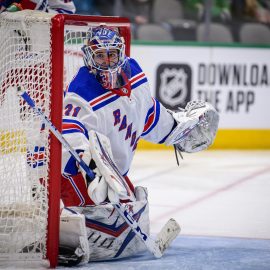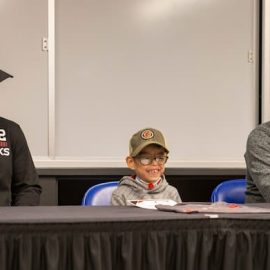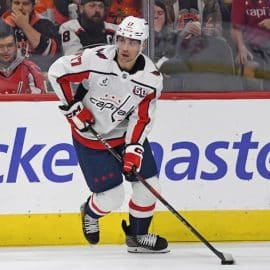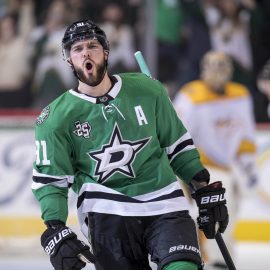They’re baaaaaaaaack.
It’s finally here, the day we’ve been waiting for. I don’t know about anyone else, but I’ve just been sitting staring at the calendar for months. Tonight, the Oilers open their season with a home game against Vancouver. Stop me if you’ve heard that before. In amongst all the traditional noise, something else has gotten a lot of attention this week, and I felt it might be appropriate to address before the first game has been played so I can try to avoid the unavoidable – hindsight bias.
It looks like Connor McDavid and Leon Draisaitl are going to be reunited on the Oilers’ first line. This, if you peruse Oilers Twitter, is apocalyptic. After all, contracts were offered to (and signed by) three forwards ostensibly to play on the Wonder Twins’ respective wings (First Ryan Nugent-Hopkins, then Zach Hyman, and then – finally – Kailer Yamamoto). So, what gives?
In the past, I’ve been as vocal as anyone (well, maybe not anyone) about my opinion that playing #97 and #29 on the same line is a terrible, horrible, no good, very bad idea. And in general, I’ve not yet seen anything to convince me otherwise. But it’s important not to get ahead of ourselves; let’s remember why that’s a bad idea, or at least, why it has been a bad idea in the past. At various points in previous seasons, the Oilers have loaded up their top line. Historically, that means two things: 1) The best first line in hockey, and 2) the worst bottom-nine in hockey (approximately). In other words, doing so made them very, very top-heavy. Looking ahead to this season, the first point hasn’t changed. I’ve seen nothing to convince me Connor and Leon won’t dominate when paired together, and in fact, I wouldn’t be surprised if they each have another gear hidden somewhere. The critical question we have to ask ourselves is: Has #2 changed? If the Oilers load up the top line, how bad (or good) is the bottom nine? Of course, without them having played a single meaningful game yet, that question is not conclusively answerable. But, various stats, analytics, and experience can give us clues as to what might happen in the Oilers’ bottom nine sans-Leon. And at first glance, it seems like a number of potentially consequential changes have happened since last year.
First, unlike last year, there’s a distinct top-six group. Last season, the second-line left wing spot was a revolving door, at various points being occupied by Dominik Kahun, RNH, Tyler Ennis, James Neal, and even Kyle Turris. There are some distinctly bottom-six forwards in that group. In fact, only one of them is currently on an NHL deal making more than $1.7 million. This season, I wouldn’t expect any of Jesse Puljujarvi, Yamamoto, RNH nor Hyman to play substantial bottom-six minutes. In fact, you could argue the Oilers may have one or two more top-six forwards playing on the third line or even in Bakersfield, but that’s a conversation for another day.
Not only that, but for the first time in recent memory, juggling the lines like this changes nothing on the third or fourth lines. Those lines will have plenty of time to develop chemistry, and with any luck (and a little Perlini magic) they’ll turn into very effective lines. All this is to say: If Connor and Leon spend any significant time together, the second line is very likely made up of three of Puljujarvi, Yamamoto, RNH, and Hyman, and there’s a nonzero chance that there’s a dangerous line in there somewhere. But you don’t have to take my word for it. Dom at the Athletic’s model projects (paywalled) Hyman-RNH-Yamamoto to be the league’s fourth-most effective second line. And that ignores the possibility of adding the bison king himself into that mix, which may make it even stronger. At the end of the day, there’s likely a very-good-to-elite second line there.
Lastly, we know from past behaviour that, even if Connor and Leon are not line mates long-term, the Oilers will at times need to run a top-six line with neither of them. Some example of this are: 1) the shift after a powerplay, because both guys will likely play the full two minutes, 2) against weaker teams who can’t line-match and shut down the nuclear option (remember, last season they reunited them late in the season to play against Ottawa, and we all know how that worked out), and 3) late in games when they’re trailing and need a goal. In other words, even if they’re not permanent line mates, McDavid and Draisaitl are going to get ice time together. Because of this, there’s value in finding out what they have in a non-Draisaitl second line early in the season.
So, am I saying that going to the nuclear option is a great idea and should be made permanent? Absolutely not. But there’s a distinct possibility that, for the first time in the McDavid era, the Edmonton Oilers could have three capable (dare I even dream to say good?) lines that include neither him nor Leon Draisaitl.
If that happens? Let ‘er rip.
Find me on Twitter @OilersRational
Add The Sports Daily to your Google News Feed!






